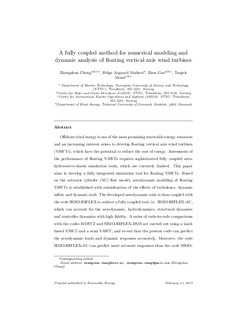| dc.contributor.author | Cheng, Zhengshun | |
| dc.contributor.author | Madsen, Helge A. | |
| dc.contributor.author | Gao, Zhen | |
| dc.contributor.author | Moan, Torgeir | |
| dc.date.accessioned | 2017-10-16T08:53:47Z | |
| dc.date.available | 2017-10-16T08:53:47Z | |
| dc.date.created | 2017-04-11T15:03:25Z | |
| dc.date.issued | 2017 | |
| dc.identifier.citation | Renewable Energy. 2017, 107 604-619. | nb_NO |
| dc.identifier.issn | 0960-1481 | |
| dc.identifier.uri | http://hdl.handle.net/11250/2460235 | |
| dc.description.abstract | Offshore wind energy is one of the most promising renewable energy resources and an increasing interest arises to develop floating vertical axis wind turbines (VAWTs), which have the potential to reduce the cost of energy. Assessment of the performance of floating VAWTs requires sophisticated fully coupled aero-hydro-servo-elastic simulation tools, which are currently limited. This paper aims to develop a fully integrated simulation tool for floating VAWTs. Based on the actuator cylinder (AC) flow model, aerodynamic modeling of floating VAWTs is established with consideration of the effects of turbulence, dynamic inflow and dynamic stall. The developed aerodynamic code is then coupled with the code SIMO-RIFLEX to achieve a fully coupled tool, i.e. SIMO-RIFLEX-AC, which can account for the aerodynamic, hydrodynamics, structural dynamics and controller dynamics with high fidelity. A series of code-to-code comparisons with the codes HAWC2 and SIMO-RIFLEX-DMS are carried out using a landbased VAWT and a semi-submersible VAWT, and reveal that the present code can predict the aerodynamic loads and dynamic responses accurately. Moreover, the code SIMO-RIFLEX-AC can predict more accurate responses than the code SIMO-RIFLEX-DMS, such as the platform motions, tower base bending moments and tension in mooring lines. | nb_NO |
| dc.language.iso | eng | nb_NO |
| dc.publisher | Elsevier | nb_NO |
| dc.rights | Attribution-NonCommercial-NoDerivatives 4.0 Internasjonal | * |
| dc.rights.uri | http://creativecommons.org/licenses/by-nc-nd/4.0/deed.no | * |
| dc.title | A fully coupled method for numerical modeling and dynamic analysis of floating vertical axis wind turbines | nb_NO |
| dc.type | Journal article | nb_NO |
| dc.type | Peer reviewed | nb_NO |
| dc.description.version | acceptedVersion | nb_NO |
| dc.source.pagenumber | 604-619 | nb_NO |
| dc.source.volume | 107 | nb_NO |
| dc.source.journal | Renewable Energy | nb_NO |
| dc.identifier.doi | 10.1016/j.renene.2017.02.028 | |
| dc.identifier.cristin | 1464874 | |
| dc.relation.project | EU/309395 | nb_NO |
| dc.relation.project | Norges forskningsråd: 223254 | nb_NO |
| dc.description.localcode | © 2017. This is the authors’ accepted and refereed manuscript to the article. LOCKED until 14.2.2019 due to copyright restrictions. This manuscript version is made available under the CC-BY-NC-ND 4.0 license http://creativecommons.org/licenses/by-nc-nd/4.0/ | nb_NO |
| cristin.unitcode | 194,64,20,0 | |
| cristin.unitname | Institutt for marin teknikk | |
| cristin.ispublished | true | |
| cristin.fulltext | postprint | |
| cristin.qualitycode | 1 | |

